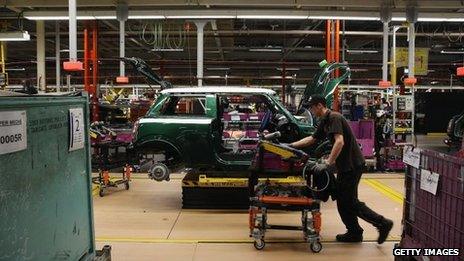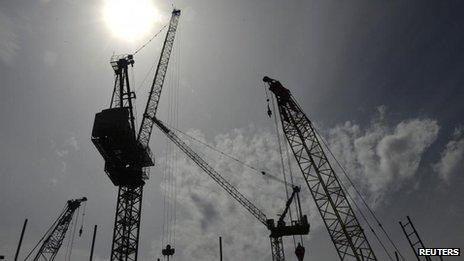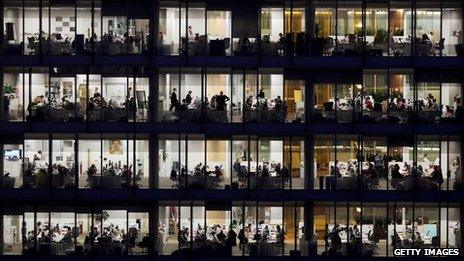Britain’s intangible recovery
- Published
- comments

The Confederation of British Industry (CBI) says that more than half (51%) of firms surveyed expect to create new jobs in 2014, the best result since the recession began.
The recovery may be in sight, but which of these businesses are driving it and which sectors have already recovered? The answers are revealing as it's not due to the economy "re-balancing".
According to the Office for National Statistics (ONS), UK GDP grew by 1.8% in the first three quarters of the year. Back in March, the Office for Budget Responsibility (OBR) predicted the economy would be only half a percent larger by this point. Yet, this month, they significantly revised up their forecasts for this year and the next.
Despite this, the UK economy is still 2.5% smaller than before the recession started at the beginning of 2008. Part of this gap reflects the sharp fall in North Sea oil and gas production over the past five years. Excluding this bit of the economy, the level of output has a smaller 1.7% to catch up.
However, if the OBR's latest forecasts turn out to be true then we will finally pass through the pre-recession level of output sometime before the end of 2014. At last!
So, which businesses are driving the recovery? And, which parts of the economy have already managed to move above their pre-recession level of output?
Manufacturing mixed
Well, it's not manufacturing. Manufacturing output as a whole is still 9% lower than before the recession started.
There are pockets of activity which are doing well. The manufacture of alcoholic beverages is above 2008 levels. There are reports that Scottish Whisky distillers, who account for a quarter of the UK's food and beverage exports, are even struggling to keep up with strong worldwide demand.
Britain's aerospace industry is also doing pretty well - largely on the back of rising global demand for commercial aircraft. For example, Airbus has so far delivered less than half the outstanding orders for its new A380 superjumbo and has over 700 orders for the new A350, which is expected to come into service next year. The wings for these aircraft are made at the Broughton factory in North Wales. Rolls-Royce is the world's second largest producer of aircraft engines with important manufacturing plants in Derby and Bristol.
Although oil and gas production is declining, the city of Aberdeen is apparently booming. Operating expenditure in the oil industry has been growing strongly as it becomes more expensive to extract the remaining oil which is harder to get to. De-commissioning expenditure is also on the rise. Furthermore, British expertise in maintaining extraction equipment, surveying and extracting hydrocarbons from difficult places are in high demand around the world.
Past recessions have caused major shake-outs in British manufacturing. The industries that survived and prospered in the aftermath have tended to be in more specialised and higher technology niches. Many have argued that a rebalancing of the British economy should involve going back to making more things. But, will it really be any different this time? And if not, should it be?
Property snakes and ladders

The commercial property sector accounts for most of the current weakness
In the construction sector, output is 13% lower than before the recession.
House building has been subdued. Last year, the number of completed new dwellings fell to 125,000; around 100,000 fewer than were being constructed in 2006 and far below the 300,000 per year that many experts argue we need to meet long-term demand.
But it is the commercial property sector which accounts for most of the current weakness. At present, there is not much demand for new retail parks and office blocks with stagnant rents and higher than normal vacancy rates. The outlook is improving, but in many parts of the country and especially outside the prime areas of London and the South East, commercial property values are still below build costs.
The sticky credit conditions since the financial crisis provide a double whammy for the construction industry. Buyers cannot raise loans to purchase properties and construction companies find it difficult to secure financing for major new projects. The hit is on both the demand and supply side of the industry.
Services to the rescue
The latest ONS data shows service sector output has edged above its pre-recession level. However, it is a large sector, accounting for around 80% of annual output, consisting of a myriad of different activities, and performance within it has been a mixed bag.
Two sectors which have, unsurprisingly, done badly are banking and government administration. Financial services output is still 13% lower than pre-crisis levels despite the better performing pension and insurance industries. In the public administration and defence sector, output has been falling steadily and is now more than 10% lower than at the start of 2008. George Osborne's continuing squeeze on public spending is likely to push this even lower.
There are four main sectors that are driving the services recovery.
Three of these have essentially been "recession-proof," so largely immune to any real downturn in activity.
Output in the telecommunications and information technology industries is currently 15% higher than in the first quarter of 2008. The growing appetite for new technologies from households and businesses has continued unabated despite the depth of the recession.

Business activity increasingly consists of people sitting in front of computers
Real estate activities are 9% higher, which on the one hand is slightly surprising when you consider that property sales are presently trundling along at about half the level of 2006-07. However, activity appears to have switched to a stronger rental market and a surge in overseas buyers has contributed to a boom in the prime London market.
The health sector has been growing by about 3% per year and output is now 15% higher than at the start of 2008. The output of the National Health Service (NHS) is largely determined by the flow of its inputs and this is one part of government that has been largely spared the cuts.
Business and professional services contracted sharply during the recession. This includes a broad range of business-to-business services including legal, accountancy, management consultancy, architecture, scientific and technical research and consultancy, administrative and support services, human resources, public relations, and so on. Compared with the first quarter of 2008, output was 15% lower by the third quarter of 2009; but has recovered strongly and is now more than 6% higher.
From the tangible to the intangible
In the somewhat distant past, it has been said that Britain is "the workshop to the world" and "a nation of shopkeepers". Neither has been true for a while. Goods rolling off the production line or money changing hands in shops are the types of tangible activities that used to be the mainstay of the economy.
However, business activity increasingly consists of people sitting in front of computer screens and having meetings to appraise projects. Britain's economy is more and more based on advising the world on how and where to invest, how to organise their companies, proposing better designs for products, writing contracts, preparing accounts and offering technical advice in the worlds of engineering, IT, architecture and finance.
The output of these activities takes the form of blueprints, designs, specifications, recommendations, computer code, ideas, reports, databases, and the like.
These intangible activities are a major part of Britain's post-recession economy -- even if it is harder to see what's being produced.